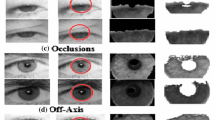Abstract
As a part of a growing information society, nowadays the issue of security is more crucial than ever. In order to achieve high level of security, the potential of accurately recognize subjects based on their unique measurable physiological or behavioral characteristics has been receiving an increased concern by the research and development community. As biometrics has advanced, iris has been considered a preferred trait because unique pattern texture, lifetime stability, and regular shape contribute to good segmentation and recognition performance. The incredible uniqueness of iris patterns as well as the ability to capture iris images non-invasively has motivated us to develop automated system for iris recognition based on 2-D iris images. The 2DPCA (two-dimensional Principal Component Analysis) and GA (Genetic Algorithm) have been used as feature extraction and feature selection techniques for reducing the dimensionality of iris features without the loss of relevant Information. The Back Propagation Neural Network (BPNN) is implemented using Levenberg–Marquardt’s learning rule for iris recognition. The experimental results illustrated that the 2DPCA-GA achieved a high classification accuracy of 96.40 %.


Similar content being viewed by others
References
Daugman, J. G. (1993). High confidence visual recognition of persons by a test of statistical independence. IEEE Transactions on Pattern Analysis and Machine Intelligence, 15(11), 1148–1161.
Daugman, J. (2004). How iris recognition works. IEEE Transactions on Circuits and Systems for Video Technology, 14(1), 21–30.
Monro, D. M., Rakshit, S., & Zhang, D. (2007). DCT-based iris recognition. IEEE Transactions on Pattern Analysis and Machine Intelligence, 29(4), 586–595.
Kumar, A., & Passi, A. (2010). Comparison and combination of iris matchers for reliable personal authentication. Pattern Recognition, 43(3), 1016–1026.
Ali, M. A., & Tahir, N. M. (2014). Half iris Gabor based iris recognition. In 2014 IEEE 10th International Colloquium on Signal Processing & its Applications (CSPA), (pp. 282–287), Malaysia.
Flom, L., & Safir, A. (1987). Iris recognition system. US Patent 4641394.
Wildes, R. P., Asmuth, J. C., Green, G. L., Hsu, S. C., Kolczynski, R. J., Matey, J. R., & McBride, S. E. (1996). A machine-vision system for iris recognition. Machine Vision and Applications, 9(1), 1–8.
Lim, S., Lee, K., Byeon, O., & Kim, T. (2001). Efficient iris recognition through improvement of feature vector and classifier. ETRI Journal, 23(2), 61–70.
Bae, K., Noh, S., & Kim, J. (2003). Iris feature extraction using independent component analysis. In International Conference on Audio-and Video-Based Biometric Person Authentication (pp. 838–844). Springer, Berlin, Heidelberg.
Shi, J. X., & Gu, X. F. (2010). The comparison of iris recognition using principal component analysis, independent component analysis and Gabor wavelets. In 2010 3rd International Conference on Computer Science and Information Technology (Vol. 1, pp. 61–64). Piscataway: IEEE.
Patil, P. S., Kolhe, S. R., Patil, R. V., & Patil, P. M. (2012). The comparison of iris recognition using principal component analysis, log gabor and gabor wavelets. International Journal of Computer Applications, 43(1), 29–33.
Mattar, E. (2013). Principal components analysis based iris recognition and identification system. International Journal of Soft Computing and Engineering (IJSCE), 3(2).
Eskandari, M., Toygar, Ö, & Demirel, H. (2013). A new approach for face-iris multimodal biometric recognition using score fusion. International Journal of Pattern Recognition and Artificial Intelligence, 27(03), 1356004.
Sun, J., Lu, Z. M., & Zhou, L. (2014). Iris Recognition using curvelet transform based on principal component analysis and linear discriminant analysis. Journal of Information Hiding and Multimedia Signal Processing, 5(3), 567–573.
Buddharpawar, A. S., & Subbaraman, S. (2015). Iris recognition based on pca for person identification. International Journal of Computer Applications, 975, 8887.
Firake, S. G., & Mahajan, P. M. (2016). Comparison of iris recognition using gabor wavelet, principal component analysis and independent component analysis. International Journal of Innovative Research in Computer and Communication Engineering, 4(6), 12334–12342.
Hamd, M. H., & Ahmed, S. K. (2018). Biometric system design for iris recognition using intelligent algorithms. International Journal of Modern Education and Computer Science, 10(3), 9–16.
Jasim, Y. A., Al-Ani, A. A., & Al-Ani, L. A. (2018). Iris recognition using principal component analysis. In Proc. 2018 1st Annual International Conference on Information and Sciences (AiCIS) (pp. 89–95), Fallujah, Iraq.
Rana, H. K., Azam, M. S., Akhtar, M. R., Quinn, J. M., & Moni, M. A. (2019). A fast iris recognition system through optimum feature extraction. PeerJ Computer Science, 5, 1–9.
CASIA iris image database. http://biometrics.idealtest.org/.
Haiyang, Z. (2011). A Comparison of PCA and 2DPCA in Face Recognition. In Electrical Power Systems and Computers (pp. 445–449). Berlin: Springer.
Lowe, D. G. (2004). Distinctive image features from scale-invariant keypoints. International Journal of Computer Vision, 60(2), 91–110.
Holland, J. H. (1992). Adaptation in natural and artificial systems: an introductory analysis with applications to biology, control, and artificial intelligence. Cambridge: MIT Press.
Basheer, I. A., & Hajmeer, M. (2000). Artificial neural networks: fundamentals, computing, design, and application. Journal of Microbiological Methods, 43(1), 3–31.
Shah, S., & Ross, A. (2009). Iris segmentation using geodesic active contours. IEEE Transactions on Information Forensics and Security, 4(4), 824–836.
Roy, K., & Bhattacharya, P. (2009). Nonideal iris recognition using level set approach and coalitional game theory. In International Conference on Computer Vision Systems (pp. 394–402). Springer, Berlin, Heidelberg.
Ukpai, C. O. (2016). Biometric iris image segmentation and feature extraction for iris recognition, Doctoral dissertation, Newcastle University, UK.
Author information
Authors and Affiliations
Corresponding author
Additional information
Publisher’s Note
Springer Nature remains neutral with regard to jurisdictional claims in published maps and institutional affiliations.
Rights and permissions
About this article
Cite this article
Garg, M., Arora, A. & Gupta, S. An Efficient Human Identification Through Iris Recognition System. J Sign Process Syst 93, 701–708 (2021). https://doi.org/10.1007/s11265-021-01646-2
Received:
Revised:
Accepted:
Published:
Issue Date:
DOI: https://doi.org/10.1007/s11265-021-01646-2




